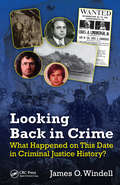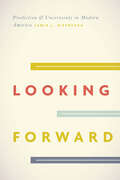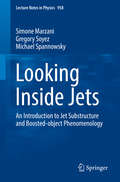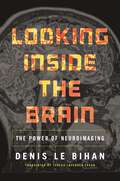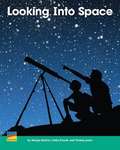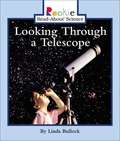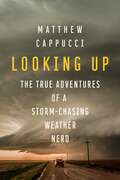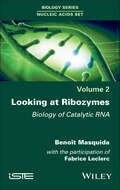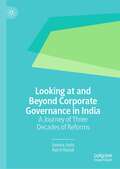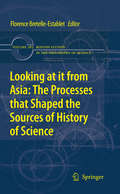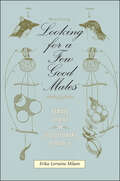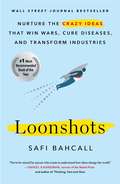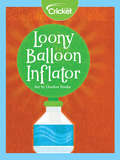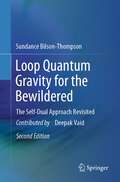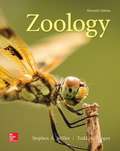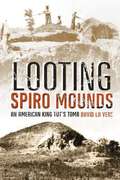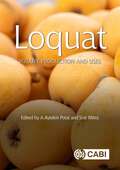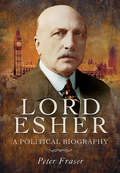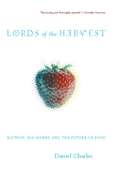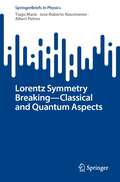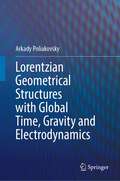- Table View
- List View
Looking Back in Crime: What Happened on This Date in Criminal Justice History?
by James O. WindellJust as people are captivated by murder mysteries, detective stories, and legal shows, they are also compulsively interested in the history of criminal justice. Looking Back in Crime: What Happened on This Day in Criminal Justice History? features a treasure trove of important dates and significant events in criminal justice history.Offering hundre
Looking Forward: Prediction and Uncertainty in Modern America
by Jamie L. PietruskaIn the decades after the Civil War, the world experienced monumental changes in industry, trade, and governance. As Americans faced this uncertain future, public debate sprang up over the accuracy and value of predictions, asking whether it was possible to look into the future with any degree of certainty. In Looking Forward, Jamie L. Pietruska uncovers a culture of prediction in the modern era, where forecasts became commonplace as crop forecasters, “weather prophets,” business forecasters, utopian novelists, and fortune-tellers produced and sold their visions of the future. Private and government forecasters competed for authority—as well as for an audience—and a single prediction could make or break a forecaster’s reputation. Pietruska argues that this late nineteenth-century quest for future certainty had an especially ironic consequence: it led Americans to accept uncertainty as an inescapable part of both forecasting and twentieth-century economic and cultural life. Drawing together histories of science, technology, capitalism, environment, and culture, Looking Forward explores how forecasts functioned as new forms of knowledge and risk management tools that sometimes mitigated, but at other times exacerbated, the very uncertainties they were designed to conquer. Ultimately Pietruska shows how Americans came to understand the future itself as predictable, yet still uncertain.
Looking Inside Jets: An Introduction to Jet Substructure and Boosted-object Phenomenology (Lecture Notes in Physics #958)
by Simone Marzani Gregory Soyez Michael SpannowskyThis concise primer reviews the latest developments in the field of jets. Jets are collinear sprays of hadrons produced in very high-energy collisions, e.g. at the LHC or at a future hadron collider. They are essential to and ubiquitous in experimental analyses, making their study crucial. At present LHC energies and beyond, massive particles around the electroweak scale are frequently produced with transverse momenta that are much larger than their mass, i.e., boosted. The decay products of such boosted massive objects tend to occupy only a relatively small and confined area of the detector and are observed as a single jet. Jets hence arise from many different sources and it is important to be able to distinguish the rare events with boosted resonances from the large backgrounds originating from Quantum Chromodynamics (QCD). This requires familiarity with the internal properties of jets, such as their different radiation patterns, a field broadly known as jet substructure. This set of notes begins by providing a phenomenological motivation, explaining why the study of jets and their substructure is of particular importance for the current and future program of the LHC, followed by a brief but insightful introduction to QCD and to hadron-collider phenomenology. The next section introduces jets as complex objects constructed from a sequential recombination algorithm. In this context some experimental aspects are also reviewed. Since jet substructure calculations are multi-scale problems that call for all-order treatments (resummations), the bases of such calculations are discussed for simple jet quantities. With these QCD and jet physics ingredients in hand, readers can then dig into jet substructure itself. Accordingly, these notes first highlight the main concepts behind substructure techniques and introduce a list of the main jet substructure tools that have been used over the past decade. Analytic calculations are then provided for several families of tools, the goal being to identify their key characteristics. In closing, the book provides an overview of LHC searches and measurements where jet substructure techniques are used, reviews the main take-home messages, and outlines future perspectives.
Looking Inside the Brain: The Power of Neuroimaging
by Denis Le BihanThe remarkable story of how today's brain scanning techniques were developed, told by one of the field's pioneersIt is now possible to witness human brain activity while we are talking, reading, or thinking, thanks to revolutionary neuroimaging techniques like magnetic resonance imaging (MRI). These groundbreaking advances have opened infinite fields of investigation—into such areas as musical perception, brain development in utero, and faulty brain connections leading to psychiatric disorders—and have raised unprecedented ethical issues. In Looking Inside the Brain, one of the leading pioneers of the field, Denis Le Bihan, offers an engaging account of the sophisticated interdisciplinary research in physics, neuroscience, and medicine that have led to the remarkable neuroimaging methods that give us a detailed look into the human brain.Introducing neurological anatomy and physiology, Le Bihan walks readers through the historical evolution of imaging technology—from the x-ray and CT scan to the PET scan and MRI—and he explains how neuroimaging uncovers afflictions like stroke or cancer and the workings of higher-order brain activities, such as language skills. Le Bihan also takes readers on a behind-the-scenes journey through NeuroSpin, his state-of-the-art neuroimaging laboratory, and goes over the cutting-edge scanning devices currently being developed. Considering what we see when we look at brain images, Le Bihan weighs what might be revealed about our thoughts and unconscious, and discusses how far this technology might go in the future.Beautifully illustrated in color, Looking Inside the Brain presents the trailblazing story of the scanning techniques that provide keys to previously unimagined knowledge of our brains and our selves.
Looking Into Space
by Tammy Jones Margie Burton Cathy French Kathleen KucheraThis book is about space and the solar system.
Looking Through A Telescope (Rookie Read-About Science)
by Linda Bullock"Simple text and photographs describe and illustrate how to use a telescope." Other books in this series are available in this library.
Looking Up: The True Adventures of a Storm-Chasing Weather Nerd
by Matthew CappucciAn energetic and electrifying narrative about all things weather—by one of today's rising meteorological stars.Get in—we&’re going storm-chasing! Imagine a very cool weather nerd has just pulled up to you and yelled this out the window of his custom-built armored storm-chasing truck. The wind is whipping around, he&’s munching on Wawa, it&’s all very chaotic—yet as you look into his grinning face, you feel the greatest surge of adrenaline you have ever felt in your life. Hallelujah: your cavalry is here! Welcome to the brilliance of Looking Up, the lively new book from rising meterology star Matthew Cappucci. He&’s a meteorologist for The Washington Post, and you might think of him as Doogie Howser meets Bill Paxton from Twister, with a dash of Leonardo DiCaprio from Catch Me If You Can. A self-proclaimed weather nerd, at the age of fourteen he talked his way into delivering a presentation on waterspouts at the American Meteorological Society's annual broadcast conference by fudging his age on the application and created his own major on weather science while an undergrad at Harvard. Combining reportage and accessible science with personal storytelling and infectious enthusiasm, Looking Up is a riveting ride through the state of our weather and a touching story about parents and mentors helping a budding scientist achieve his improbable dreams. Throughout, readers get a tutorial on the basics of weather science and the impact of the climate. As our country&’s leaders sound the alarm on climate change, few people have as close a view to how serious the situation actually is than those whose job is to follow the weather, which is the daily dose of climate we interact with and experience every day. The weather affects every aspect of our lives (even our art) as well as our future. The way we think about it requires a whole-life overhaul. Rain or shine, tropical storm or twister, Cappucci is here to help us begin the process. So get in his storm-chasing truck already, will ya?
Looking at Ribozymes: Biology of Catalytic RNA
by Benoît MasquidaBehind the neologism “ribozymes” lies a family of fascinating molecules, ribo-enzymes, which have been relatively little studied. These catalytically active RNAs are found in all strata of life, from viruses to the human genome. At the end of the 1970s, the discovery of a catalytic RNA nestled in an intron, followed by another involved in the maturation of transfer RNAs, led to the discovery of new ribozymes and the transition from a strictly “proteocentric” vision, inherited from the dogma of molecular biology, to a more “nucleocentric” one. Since then, a variety of ribozymes have been identified in genomes, where their functions often remain mysterious. Looking at Ribozymes traces the discovery of these molecules and presents a picture of their functional diversity, catalytic mechanisms and distribution within the tree of life.
Looking at and Beyond Corporate Governance in India: A Journey of Three Decades of Reforms
by Seema Joshi Ruchi KansilThis book explores theoretical and empirical perspectives on corporate governance and sustainability and reflects upon India’s three decades of corporate governance reforms. It provides a solid base of information culled from extensive empirical research. It will contribute to the 2030 agenda of the United Nations on Sustainable Development Goals by lighting the way forward and enhancing the convergence of corporate governance with sustainability in business entities. Adopting a credible and uniform sustainability reporting framework and cultivating a pervasive “sustainability culture” through effective “sustainability leadership” has become a business imperative. It will be highly relevant for all stakeholders, including shareholders, boards of directors, managers, academicians, and researchers, and it will empower, enrich, and enable them to gain more conceptual clarity and empirical understanding of corporate governance and sustainability issues. In addition, it shows the pathway for policymakers and practitioners to address the myriad challenges that emanate from sustainability by suggesting new approaches emerging in the critical domain of corporate governance.
Looking at it from Asia: the Processes that Shaped the Sources of History of Science
by Karine Chemla Agathe Keller Christine Proust Catherine Jami Florence Bretelle-EstabletThe idea of this volume took shape within a group of scholars working on the history of science in Asia. Despite the great differences in time, locations and disciplines between our respective fields of research, we all faced similar situations: among the huge mass of written documents available to historians and that were eventually taken as sources in the historiography of science, some had been well studied while others had been dismissed or ignored. This observation will seem obvious to historians, whose daily work consists in shaping corpuses to raise new questions. The diagnosis has long been established that such selections related to the historians' agenda and thereby reflected the ways in which historiography somehow belonged to its time. Yet, it appeared to us that this diagnosis was insufficient and that the selective consideration of source material was also at least partly related to mechanisms of selection that occurred upstream from the historian's classical work of shaping a corpus. Therefore, we came to the idea that, in order to write, or to rewrite, chapters in the history of science, historians may benefit from relying on a critical analysis of the factors that, along history, shaped the documents that have become their sources or the collections from which they constitute their corpuses. It is to the development of such a branch of critical analysis in the history of science, to its methods and to its benefits --to be illustrated in carefully chosen case studies--, that we suggest to devote a collective research and a book. We want to inquire into how the corpuses we form incorporate long sequences of selections and reorganizations that took place in history and that must be brought to light if we do not want various types of actors of the past to carve their choices and conceptions into our questions and conclusions.
Looking for Earth 2 (Fountas & Pinnell LLI Gold #Level M)
by Julie WinterbottomLooking for Earth 2 Author: Julie Winterbottom
Looking for Earths: The Race to Find New Solar Systems
by Alan BossA popular science treatment of the personalities, projects, and theories, that have gone into the continuing attempt to find planetary-size objects orbiting nearby stars. The story is told chronologically from Peter van der Kamp's 1963 announcement of a planet orbiting Barnard's star to the 1996-97 confirmed discoveries of a number of planets. Annotation c. Book News, Inc., Portland, OR (booknews.com)
Looking for Spinoza: Joy, Sorrow, and the Feeling Brain
by Antonio DamasioA famed neuroscientist explores the emotions that make life worth living in &“clear, accessible, and at times eloquent prose&” (San Francisco Chronicle). In the seventeenth century, the philosopher Spinoza examined the role emotion played in human survival and culture. Yet, the neurobiological roots of joy and sorrow remained a mystery. Today, we spend countless resources doctoring our feelings with alcohol, prescription drugs, health clubs, therapy, vacation retreats, and other sorts of consumption; yet the inner workings of our minds—what feelings are, how they work, and what they mean—are still largely an unexplored frontier. Here, bestselling author and distinguished scientist Antonio Demasio concludes the groundbreaking trilogy he began with Descartes&’ Error by drawing on his innovative research and experience with neurological patients to examine the cerebral processes of human emotion. With scientific expertise and &“a flair for writing,&” he navigates the neurology of feelings (The New York Review of Books). &“Damasio has the rare talent of rendering science intelligible while also being gifted in philosophy, literature and wit.&” —Margaret Jacob, Los Angeles Times &“Exceptionally engaging and profoundly gratifying . . . Achieves a unique combination of scientific exposition, historical discovery and deep personal statement regarding the human condition.&” —Nature &“Damasio . . . succeeds in making the latest brain research accessible to the general reader, while his passionate Spinozist reflections make that data relevant to everyday life.&” —Publishers Weekly
Looking for a Few Good Males: Female Choice in Evolutionary Biology (Animals, History, Culture)
by Erika L. Milam2010 Outstanding Academic Title, Choice MagazineWhy do female animals select certain mates, and how do scientists determine the answer? In considering these questions, Erika Lorraine Milam explores the fascinating patterns of experiment and interpretation that emerged as twentieth-century researchers studied sexual selection and female choice. Approaching the topic from both biological and animal-studies perspectives, Milam not only presents a broad history of sexual selection—from Darwin to sociobiology—but also analyzes the animal-human continuum from the perspectives of sex, evolution, and behavior. She asks how social and cultural assumptions influence human-animal research and wonders about the implications of gender on scientific outcomes. Although female choice appears to be a straightforward theoretical concept, the study of sexual selection has been anything but simple. Scientists in the early twentieth century investigated female choice in animals but did so with human social and sexual behavior as their ultimate objective. By the 1940s, evolutionary biologists and population geneticists shifted their focus, studying instead how evolution affected natural animal populations. Two decades later, organismal biologists once again redefined the investigation of sexual selection as sociobiology came to dominate the discipline.Outlining the ever-changing history of this field of study, Milam uncovers lost mid-century research programs and finds that the discipline did not languish in the decades between Darwin’s theory of sexual selection and sociobiology, as observers commonly believed. Rather, population geneticists, ethologists, and organismal biologists alike continued to investigate this important theory throughout the twentieth century.
Loonshots: How to Nurture the Crazy Ideas That Win Wars, Cure Diseases, and Transform Industries
by Safi Bahcall* Next Big Idea Club Selection *Washington Post's "10 Leadership Books to Watch for in 2019," Adam Grant's "19 New Leadership Books to Read in 2019," Inc.com's "10 Business Books You Need to Read in 2019," Business Insider's "14 Books Everyone Will Be Reading in 2019"“This book has everything: new ideas, bold insights, entertaining history and convincing analysis. Not to be missed by anyone who wants to understand how ideas change the world.” —Daniel Kahneman, winner of the Nobel Prize and author of Thinking, Fast and Slow What do James Bond and Lipitor have in common? What can we learn about human nature and world history from a glass of water?In Loonshots, physicist and entrepreneur Safi Bahcall reveals a surprising new way of thinking about the mysteries of group behavior that challenges everything we thought we knew about nurturing radical breakthroughs.Drawing on the science of phase transitions, Bahcall shows why teams, companies, or any group with a mission will suddenly change from embracing wild new ideas to rigidly rejecting them, just as flowing water will suddenly change into brittle ice. Mountains of print have been written about culture. Loonshots identifies the small shifts in structure that control this transition, the same way that temperature controls the change from water to ice.Using examples that range from the spread of fires in forests to the hunt for terrorists online, and stories of thieves and geniuses and kings, Bahcall shows how this new kind of science helps us understand the behavior of companies and the fate of empires. Loonshots distills these insights into lessons for creatives, entrepreneurs, and visionaries everywhere.Over the past decade, researchers have been applying the tools and techniques of phase transitions to understand how birds flock, fish swim, brains work, people vote, criminals behave, ideas spread, diseases erupt, and ecosystems collapse. If twentieth-century science was shaped by the search for fundamental laws, like quantum mechanics and gravity, the twenty-first will be shaped by this new kind of science. Loonshots is the first to apply these tools to help all of us unlock our potential to create and nurture the crazy ideas that change the world.
Loony Balloon Inflator
by Daniel ResnerIn this activity, you'll learn how to create a chemical reaction that inflates a balloon.
Loop Quantum Gravity for the Bewildered: The Self-Dual Approach Revisited
by Sundance Bilson-ThompsonThis second edition offers a comprehensive introduction to loop quantum gravity (LQG) in self-dual variables, including the necessary prerequisites. Additionally, it delves into various significant research areas that have emerged in recent years. New content (including an entirely new chapter dedicated to dynamics of quantum spacetime) explores the description of spin networks and spin-foams, their historical development as well as connections to tensor networks, BF theory, and emerging approaches including the spinorial representation of LQG, SU(2) coherent states, and group field theory. Furthermore, the book provides expanded appendices covering essential tools and concepts, such as the connection between information theory and entropy, and overviews of group theory and differential geometry. All topics are presented from a non-expert perspective, ensuring self-containment and accessibility. The primary aim of this second edition remains helping researchers, bewildered bythe vast array of topics within this rapidly growing field of quantum gravity, to gain a fundamental understanding of the current developments.
Loose Leaf For Zoology
by Stephen A. Miller Todd A. TupperThe 11th edition of Zoology continues to offer students an introductory general zoology text that is manageable in size and adaptable to a variety of course formats. It is a principles-oriented text written for the non-majors or the combined course, presented at the freshman and sophomore level.
Looting Spiro Mounds: An American King Tut's Tomb
by David La VereVere (history, U. of North Carolina, Wilmington) recounts the looting of the Spiro Mounds in eastern Oklahoma in 1935, which contained a large amount of pre-Columbian art. He describes the founding and settlement of the area from 800 A.D., the culture and life of the people, and the decline of the chiefdom by 1450 A.D. These chapters are interwoven with the story of how the Pocola Mining Company found the Mounds in the 1930s and looted the objects, the fight with them by U. of Oklahoma's anthropologist Forrest Clements over who had property rights, Works Progress Administration excavation, and past and present theories about Spiro and its people. Annotation ©2007 Book News, Inc., Portland, OR (booknews.com)
Loquat: Botany, Production and Uses (Botany, Production and Uses)
by Maria Luisa Badenes Shiwei Ma Julián Cuevas González Manuel Blasco Manuel Agustí Josep Armengol Vittorio Farina Elisa González-Dominguez Qigao Guo Liang Guolu Juan José Hueso Yuanyuan Jiang Francisco Legaz Hailan Lin Shoukai Lin Dahe Lin Shunquan Lin Belén Martínez-Alcántara Amparo Martínez-Fuentes Carlos Mesejo Julia Morales Ana Quiñones Carmina Reig Esteban Soler Jincheng Wu Bisha Wu Xianghui Yang Peng Ze Lifen ZhangLoquat (Eriobotrya japonica Lindl.) is a subtropical evergreen fruit tree indigenous to China. Records show it has been cultivated in China for over 2000 years. From this beginning, loquat has spread to more than 30 countries around the world. Grown in various regions of Asia, the Mediterranean and across the Americas, loquats suit both temperate and subtropical areas, sharing the same environmental conditions as citrus. Loquat is an increasingly commercial crop in some Asian and European countries with a good amount of international trade. Recent research has focused on improving crop yields and quality. Over 100 different varieties have been developed to meet both growers' and consumers' demands. These developments have contributed to a better understanding of the crop environment, plant growth and physiology of tree and fruit development with implications for both breeding and cultivation. This book is to be the first to provide a comprehensive coverage of the history, physiology, culture and marketing of loquat throughout the world.
Lord Esher: A Political Biography
by Peter FraserAlthough wielding huge influence in late Victorian and Edwardian political life, Reginald Baliol Brett (1852 1930), the second Lord Esher was, an enigma to his contemporaries and still remains a puzzle to historians.At the heart of British and Imperial political affairs for several decades, Esher sat in both Houses of Parliament, was a high ranking civil servant, friend and confidential advisor to three Sovereigns and four Prime Ministers (of differing political hues) and yet refused high office offered by both Liberals and Conservatives. Yet his behind-the-scenes influence through his range of friends in high places gave him unmatched, some thought undemocratic, power. Despite his lack of military service he was instrumental through his work on the Committee for Imperial Defence (CID) and its Secretarial for the wholesale reorganisation of the Armed Forces. It could be said that Esher, with his grasp of power without responsibility, was a unique phenomenon in British history.The Author, while compiling this fascinating study, drew on Cabinet and CID files, the Royal Archives and the papers of the Esher, Balfour, Asquith and Lloyd George estates. The result is a brilliant readable yet scholarly addition to British political bibliography.
Lords of the Harvest: Biotech, Big Money, and the Future of Food
by Daniel CharlesBiotech companies are creating designer crops with strange powers-from cholesterol-reducing soybeans to tobacco plants that act as solar-powered pharmaceutical factories. They promise great benefits: better health for consumers and more productive agriculture. But the vision has a dark side. In Lords of the Harvest, Daniel Charles tells the real story behind "Frankenstein foods"-the story you won't hear from the biotech companies or their fiercest opponents. He reveals for the first time the cutthroat scientific competition and backroom business deals that led to the first genetically engineered foods. And he exposes the secrets of campaigns on both sides of the Atlantic aimed at bringing down the biotech industry. A riveting tale of boundless ambition, political intrigue, and the quest for knowledge, Lords of the Harvest is ultimately a story of idealism and conflicting dreams about the shape of a better world.
Lorentz Symmetry Breaking—Classical and Quantum Aspects (SpringerBriefs in Physics)
by Albert Petrov Tiago Mariz Jose Roberto NascimentoThis book presents a review of various issues related to Lorentz symmetry breaking. Explicitly, we consider (i) motivations for introducing Lorentz symmetry breaking, (ii) classical aspects of Lorentz-breaking field theory models including typical forms of Lorentz-breaking additive terms, wave propagation in Lorentz-breaking theories, and mechanisms for breaking the Lorentz symmetry; (iii) quantum corrections in Lorentz-breaking theories, especially the possibilities for perturbation generating the most interesting Lorentz-breaking terms; (iv) correspondence between non-commutative field theories and Lorentz symmetry breaking; (v) supersymmetric Lorentz-breaking theories; and (vi) Lorentz symmetry breaking in a curved space-time. We close the book with the review of experimental studies of Lorentz symmetry breaking. The importance and relevance of these topics are explained, first, by studies of limits of applicability of the Lorentz symmetry, second, by searches of the possible extensions of the standard model, including the Lorentz-breaking ones, and need to study their properties, third, by the relation between Lorentz symmetry breaking with string theory, fourth, by the problem of formulating a consistent quantum gravity theory, so that various modified gravity models are to be examined.
Lorentzian Geometrical Structures with Global Time, Gravity and Electrodynamics
by Arkady PoliakovskyThis book investigates Lorentzian structures in the four-dimensional space-time, supplemented either by a covector field of the time-direction or by a scalar field of the global time. Furthermore, it proposes a new metrizable model of gravity. In contrast to the usual General Relativity theory, where all ten components of the symmetric pseudo-metric are independent variables, the gravity model presented here essentially depends only on a single four-covector field, and is restricted to have only three-independent components. However, the author proves that the gravitational field, governed by the proposed model and generated by some massive body, resting and spherically symmetric in some coordinate system, is given by a pseudo-metric that coincides with the well known Schwarzschild metric from General Relativity. The Maxwell equations and electrodynamics are also investigated in the framework of the proposed model. In particular, the covariant formulation of electrodynamics of moving dielectrics and para/diamagnetic media is derived.

